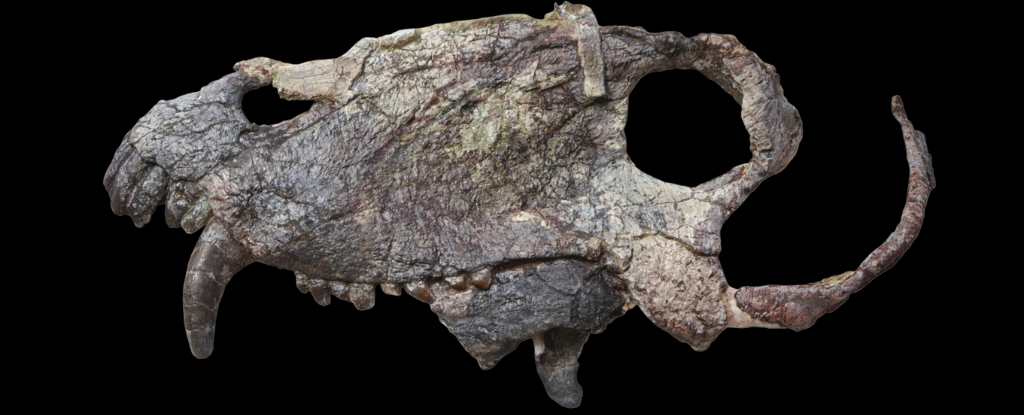Giant Dinosaur Skull Discovery: Scientists Unearth a Massive Fossil of an Unknown Species
In a groundbreaking discovery that has left paleontologists around the world buzzing with excitement, a team of researchers has uncovered the fossilized skull of a massive, previously unknown dinosaur species. Found buried deep within the rocky terrain of Montana, USA, the fossil’s sheer size and unusual features suggest that this creature may have been among the most formidable predators to ever roam the Earth.
The skull, measuring an astonishing 7 feet in length, is remarkably well-preserved, showcasing razor-sharp teeth, a massive jaw structure, and intricate bone ridges that hint at its evolutionary uniqueness. Scientists believe the creature likely lived during the Late Cretaceous period, approximately 70 million years ago, making it a contemporary of famous predators like Tyrannosaurus rex. However, the newly discovered dinosaur appears to have been far larger and possibly even more fearsome.
High-resolution photos of the skull have already been released by the research team, and they are nothing short of jaw-dropping. The fossil reveals a skull with jagged, shark-like teeth that could grow up to 12 inches long, an unusually deep jawbone, and mysterious, ridged crests above the eyes that may have been used for intimidation or mating displays. Scientists have nicknamed the species “Titanomax,” meaning “Giant Ruler,” until it is officially classified.

“Based on the size of the skull alone, we estimate that Titanomax was at least 45 feet long and weighed over 15 tons,” said Dr. Laura Hensworth, the lead paleontologist on the project. “Its anatomy is unlike anything we’ve seen before. This could completely reshape our understanding of apex predators during the Cretaceous period.”
The excavation site in Montana, dubbed the “Valley of Giants,” has long been known for its rich deposits of fossils, but this latest find is extraordinary even by those high standards. The discovery was made in early December when a research team from the University of California, Berkeley, stumbled upon what they initially thought was a boulder protruding from the hillside. Upon closer inspection, the “boulder” revealed itself to be a jaw fragment belonging to a giant carnivorous dinosaur.
With the help of advanced imaging techniques, including 3D scanning and X-ray analysis, researchers were able to digitally reconstruct the skull and determine its astonishing size and shape. Excavation efforts are still ongoing, as scientists suspect that additional parts of the skeleton, including its spine and legs, may be buried nearby.
“This is a once-in-a-lifetime discovery,” added Dr. Hensworth. “We’re not just uncovering bones; we’re uncovering a window into an ancient ecosystem that has been hidden for millions of years.”
While comparisons to the T. rex are inevitable, scientists stress that Titanomax is likely an entirely different genus. Unlike the T. rex, which had relatively small arms and a streamlined body, Titanomax appears to have been bulkier, with robust limb structures that may have allowed it to dominate its environment in unique ways.
The discovery raises important questions about the diversity of large predators during the Cretaceous period. Could Titanomax have competed with T. rex for food and territory, or did it occupy a completely different ecological niche?
“It’s thrilling to imagine how these two titans might have interacted,” said Dr. Mark Delaney, a paleobiologist from the Natural History Museum in London. “We may be on the verge of uncovering an entirely new chapter in the story of dinosaur evolution.”
The discovery has sparked global interest, with scientists, dinosaur enthusiasts, and social media users eagerly awaiting further updates. Plans are already underway to conduct a full excavation of the site in the coming months, and researchers hope to find more fossilized remains that could provide insight into Titanomax’s diet, behavior, and habitat.
Meanwhile, the fossilized skull will be transported to a state-of-the-art laboratory, where it will undergo further analysis. Once studied, the fossil is expected to be displayed at a major museum, giving the public a chance to marvel at this prehistoric giant.
As the scientific world grapples with the implications of this monumental find, one thing is clear: the age of the dinosaurs still holds many secrets, and Titanomax is poised to take its place as one of the most fascinating creatures ever to emerge from the fossil record.
Stay tuned for more updates as researchers continue to uncover the mysteries of this awe-inspiring prehistoric predator!
Leave a Reply